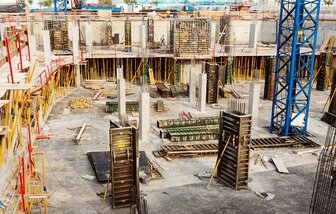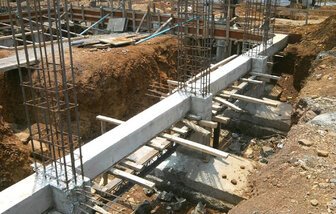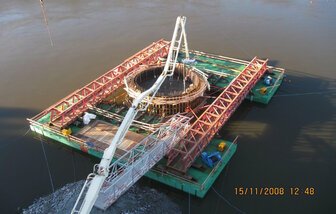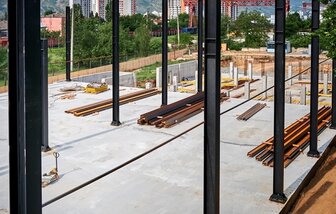Pile Raft Foundations
A Learn all about piled foundations in the UK, including what they are, why they are chosen, and the different types available. Find out how piled foundations are constructed and why they are important for building stability. Consult with a qualified engineer or foundation specialist to determine the most suitable foundation for your specific requirements
What is a Pile Raft Building Foundation?
When it comes to constructing a solid and stable foundation for buildings, engineers and architects are constantly exploring innovative techniques.
One such technique gaining popularity is the pile raft building foundation. This unique approach combines the benefits of both pile foundations and raft foundations, providing a strong and efficient solution for various construction projects.
Pile raft building foundation, also known as piled raft foundation, is a type of foundation system that combines piles and a raft slab. It involves the installation of piles at specific locations beneath the entire footprint of the building, which are then connected by a reinforced concrete raft slab.
This integrated system distributes the load of the structure evenly across the piles and the raft, ensuring stability and preventing excessive settlement.

1. Enhanced Load-Bearing Capacity: By combining the load-bearing capacity of both piles and raft slabs, pile raft foundations can handle heavier loads compared to traditional foundations. This makes them ideal for high-rise buildings, industrial structures, and other projects with significant vertical loads.
2. Improved Stability: The interconnected piles and raft slab create a unified system that enhances the overall stability of the structure. This helps to minimize differential settlements, which can lead to structural damage and uneven floors.
3. Cost-Effective: Pile raft foundations can be a cost-effective solution, especially in areas with challenging soil conditions. By distributing the load across multiple piles, the foundation can be designed to accommodate varying soil properties, reducing the need for extensive ground improvement techniques.
4. Time-Saving: Compared to traditional deep foundation techniques, such as individual pile foundations, pile raft foundations can save construction time. The integrated design allows for faster installation and reduces the need for extensive excavation and backfilling.
The design and construction of a pile raft building foundation require careful analysis of the site conditions, soil properties, and structural requirements. Typically, the process involves the following steps:
- Site Investigation: A thorough geotechnical investigation is conducted to assess the soil conditions, including bearing capacity, settlement characteristics, and groundwater levels.
- Structural Design: Based on the site investigation, the structural engineer determines the optimal arrangement of piles and the dimensions of the raft slab to ensure stability and meet the load requirements.
- Pile Installation: Piles are installed using various methods, such as driven piles, bored piles, or helical piles, depending on the soil conditions and project specifications.
- Raft Construction: Once the piles are in place, a reinforced concrete raft slab is constructed, connecting all the piles and providing a stable platform for the building.
- Monitoring and Maintenance: Regular monitoring and maintenance of the pile raft foundation are essential to ensure its long-term performance and structural integrity.
Piled raft building foundations are a popular choice in the construction industry due to their ability to distribute loads and provide stability. However, like any other construction method, piled raft foundations also have their disadvantages. In this article, we will explore some of the drawbacks of using piled raft foundations in the UK.
1. Cost
One of the main disadvantages of piled raft building foundations is the cost. Compared to traditional foundations, piled raft foundations can be more expensive to construct. The additional materials and labor required for installing piles and constructing the raft can significantly increase the overall project cost. This can be a deterrent for some developers or homeowners with budget constraints.
2. Time-consuming
Another disadvantage of piled raft foundations is that they can be time-consuming to install. The process of driving piles into the ground and constructing the raft can take longer than other foundation methods. This can lead to project delays and increased construction time, which may not be ideal for time-sensitive projects.
3. Site Constraints
Piled raft foundations require sufficient space for pile installation and raft construction. In areas with limited space or complex site conditions, such as dense urban environments, it may be challenging to install piles and construct the raft. This can limit the feasibility of using piled raft foundations in certain locations.
4. Environmental Impact
The installation of piled raft foundations can have an environmental impact. Driving piles into the ground can cause noise and vibration, which may disrupt nearby residents or businesses. Additionally, the extraction and transportation of materials required for the foundation can contribute to carbon emissions and environmental degradation.
5. Design Complexity
Piled raft foundations require careful design and engineering to ensure their effectiveness and stability. The design process can be more complex compared to traditional foundations, as it involves considering factors such as soil conditions, load distribution, and pile spacing. This complexity can result in higher design costs and the need for specialized expertise.
6. Maintenance
While piled raft foundations are generally durable, they may require regular maintenance over time. The condition of the piles and raft should be monitored to identify any signs of deterioration or settlement. Maintenance activities, such as inspections and repairs, can add to the long-term cost of using piled raft foundations.
Conclusion
While piled raft building foundations offer several advantages, it is essential to consider their disadvantages before choosing this construction method. The cost, time-consuming nature, site constraints, environmental impact, design complexity, and maintenance requirements are factors that need to be carefully evaluated. Consulting with experienced engineers and considering the specific requirements of the project can help determine whether piled raft foundations are the right choice for a particular construction project in the UK.
Pile raft building foundations offer a reliable and efficient solution for constructing stable structures on challenging soil conditions. By combining the load-bearing capacity of piles with the stability of raft slabs, this innovative foundation system provides enhanced structural integrity, improved stability, and cost-effective benefits. With careful design and construction, pile raft foundations can support a wide range of construction projects, from residential buildings to large-scale industrial complexes.
Soft Strip foundations
Learn about soft strip foundations, a type of shallow strip foundation commonly used in the United Kingdom. Discover how they work, their advantages, and considerations to keep in mind
Trench fill foundation
Trench fill foundations are similar to strip foundations but differ in that the trench is filled with concrete rather than individual concrete or masonry blocks.
Piled foundation
Piled foundations are used when the soil conditions are challenging or when the load on the foundation is particularly heavy. This type of foundation involves driving or drilling deep piles into the ground
What is a raft foundation?
Raft foundations are a popular choice for many construction projects, providing a stable and durable base for buildings. Explore the benefits of raft foundations, the construction process
Piled raft foundation
Piled raft foundations combine the advantages of piled foundations and raft foundations. They involve the use of both piles and a large concrete slab to distribute the load over a wider area.
Caisson foundation
Caisson foundations, also known as pier foundations, are used in areas with a high water table or poor soil conditions. This type of foundation involves drilling or excavating
Pad foundation
Pad foundations, also known as isolated footings, are used to support individual columns or posts. They consist of a single concrete pad that distributes the load from the column to the soil
Building foundation hub
At Total, we are dedicated to providing you with the essential knowledge and resources you need to build a strong foundation in various fields. Whether you are a student, professional, or simply curious a
Ready to start your project ?
Let's Work Together
To get started, for general enquiries simply complete the form below. Provide us with your project details, and our team will review your requirements. We will then get back to you with a customised solution that fits your needs. Whether you have a small-scale project or a large-scale development, we have the expertise and resources to handle it. Once we have received your submission, you will receive a confirmation email (Please check all your email boxes)
If you prefer, and have a project in mind and seeking a price you can also send us your project documents and any photographs directly to Price@totalregen.co.uk. We will carefully examine your documents and provide you with a competitive quote together with a timescale from inception through to completion for your project.








